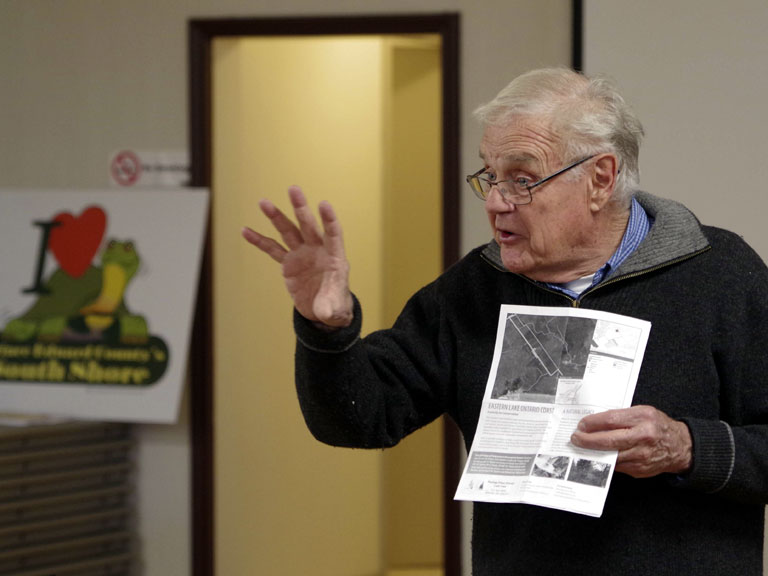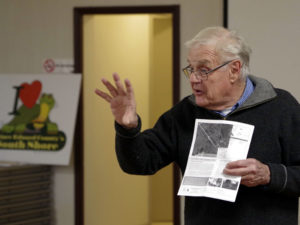County News
South Shore Symposium

Meeting focuses on cultural and natural history
About forty people attended a day-long meeting at Milford Town Hall on Saturday to hear about the natural and cultural heritage of the County’s south shore. The meeting was arranged by the South Shore Joint Initiative (SSJI), a group that aims to protect and improve the biodiversity of this environmentally significant area of the County. The symposium was intended to provide a broad overview of the south shore, from its geological history through to present day efforts to preserve its heritage status. The meeting opened with Cheryl Anderson presenting the day’s agenda and also acknowledging that the Indigenous people were inhabitants of this land prior to European settlement. Dick Bird of the Hastings Prince Edward Land Trust provided an update on Nature Conservancy Canada’s (NCC) project to buy a piece of land on the south shore that is home to the Blanding’s turtle and the eastern whip-poor-will. “Nature Conservancy wants a foothold on the south shore of Prince Edward County,” said Bird. “It’s up right near the top of the list of sensitive areas they wish to protect. There’s no question they wanted to own that property.” The land obtained by NCC is the Hudgin-Rose property, approximately 76 acres that is home to a log cabin built in 1865. Bonita Allen is the great-great-granddaughter of Moses Hudgin, who built the cabin, and her family sold the property to the Rose family a number of years ago. A juniper tree planted by Allen’s father before he went off to serve in the Second World War still stands in front of the cabin. “I’m glad to see it preserved,” said Allen. “The Nature Conservancy and Land Trust people, it’s incredible they are going to preserve that cottage. It was often a getaway for our family to have picnics around the old property.”

Dick Bird of the Hastings Prince Edward Land Trust speaks about the project to acquire environmentally sensitive land on the County’s south shore.
Liz Driver then spoke about the meaning of heritage and its importance. “History and heritage give the County its particular ‘sense of place’ and shape our identity. They make us feel attached to where we live,” she said. “The new idea of heritage is dynamic and inspiring, and provides a way of thinking about our heritage and how it can serve us over time.”
She provided several examples of heritage preservation, including the triple-gabled house on Walmsley Road that has been restored to how it might have looked in the late 19th century. She also showed how a building can be repurposed and can continue to be of enduring value to the community, giving the example of Mount Tabor as a venue for theatre and concerts.
The next speaker was Orland French, who gave a history of the County on a somewhat longer timeframe, starting about 430 million years ago. That was about the time the limestone strata was laid down. Fast forward to about 13,000 years ago when the glacial lake submerging the County finally drained, a process that took less than a thousand years—an eyeblink in geological terms. This area served as rich hunting and fishing grounds for the Indigenous people prior to the arrival of European settlers. The limestone soil that has proven such a boon to modern winemakers was the bane of many a farmer trying to eke out a living in the early days of colonization However, there was enough fertile soil to turn this area into a thriving agricultural region, and the age of sail on Lake Ontario provided a ready means of transportation. This was the topic for Marc Seguin, who spoke about the rise and demise of lighthouses around the County. In their heyday, there were 45 lighthouses girding the rocky shores of the County, warning ships of peril in the region that was then known as the graveyard of Lake Ontario. Seven of these original lighthouses remain, and efforts to preserve them have met with mixed success. The building at Point Traverse is being restored, but the fate of the lighthouse at Salmon Point—on privately owned property—looks dire.
Sacha Warunkiw next gave a presentation on the European settlement of South Marysburgh, starting with the arrival of the United Empire Loyalists in 1784 led by Major Peter Van Alstine. By the early 19th century, lumber and grist mills were established in the Black River area, and in the 1830s Milford was the leading centre of industry in the County. Over the years, the area has seen its prosperity rise and fall and rise again. Shipbuilding was a mainstay for many decades, cheese factories flourished, and for a dozen or so years rumrunning created a few fortunes. Through it all, though, daily life continued, and a glimpse of this can be found in the diaries of Nelson Hicks. Sarah Moran is the current keeper of the diaries, which were passed on to her by Vicki Emlaw, a direct descendant of Hicks. Excerpts from Hicks’ diary have been regularly published in the South Marysburgh Mirror, first by Emlaw and now by Moran. “The journals we have extend from about 1892 until the 1940s, and he wrote an entry every single day for that period,” said Moran. “They really just record his life and the life of many of his relatives and in-laws across that time period. It’s fascinating because at the beginning we’re really rooted in early agricultural lifestyle and by the end we’re in mid-twentieth century, so you see things like the massive difference cars made, that mechanization made. And they are really interesting stories that connect us directly with someone’s life.”

There is not an “s” at the end of Hudgin.
Thanks for bringing this to our attention.